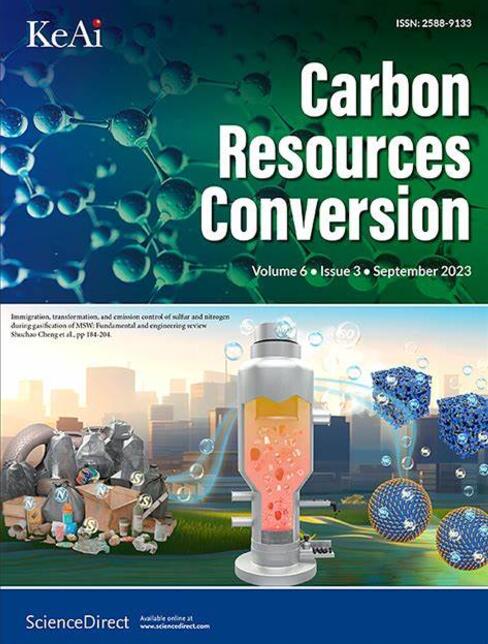以 CeO2 和 SiC 为载体的 Ni-M、Ru-M(M = Co、Mn)催化剂的 CO2 甲烷化作用
IF 7.5
3区 环境科学与生态学
Q2 ENERGY & FUELS
引用次数: 0
摘要
大气中主要温室气体二氧化碳的浓度正在迅速增加,导致全球变暖和一系列环境问题。在当前的环境背景下,二氧化碳的有效循环和利用是至关重要的。甲烷化是一种放热过程,是有效利用二氧化碳的关键策略。在这方面,迫切需要合理设计催化剂,在较宽的温度范围(250-550°C)内保持高活性和甲烷选择性。因此,即使在500°C的大气压力下也能保证持续反应的催化剂是必要的。本研究研究了以具有优异导热性的SiC和以CO 2亲和力为特征的CeO2为基础材料的双金属催化剂。我们加入Ni-M和Ru-M (M = Co和Mn)作为活性金属,各加载2%。令人印象深刻的是,在固定床管式反应器系统中,在H2/CO2 = 4,总流量为70 ml min - 1,稳定GHSV为12,000 h - 1的条件下,仅20 mg的Ni-Co/SiC催化剂在500°C下实现了77%的CO2转化率和88%的CH 4选择性。此外,在相同的条件下,2Ni-2Co/CeO2催化剂表现出优异的性能,CO2转化率为76%,CH4选择性为83%。催化剂的耐久性在随后的40小时稳定性测试中得到了证实,测试结果显示,催化剂的降解率仅为3 - 5%。采用BET/BJH、CO脉冲化学吸附、H2-TPR、HAADF-STEM-EDS、SEM-EDS、XRD等手段对所制备的催化剂进行了综合表征,揭示了催化剂的理化和表面特性。结果表明,Co和Mn相结合可有效抑制Ni和Ru颗粒的团聚,确保金属在载体上的最佳分散。综上所述,我们合成的双金属催化剂即使在高温环境下也表现出持续的催化能力。本文章由计算机程序翻译,如有差异,请以英文原文为准。

CO2 methanation over low-loaded Ni-M, Ru-M (M = Co, Mn) catalysts supported on CeO2 and SiC
The concentration of the major greenhouse gas CO2 is rapidly increasing in the atmosphere, leading to global warming and a range of environmental issues. An efficient circulation and utilization of CO2 is critical in the current environmental context. Methanation, an exothermic process, emerges as a critical strategy for effective CO2 utilization. On this front, there is a significant demand for rational design of catalysts that maintain high activity and methane selectivity over a wide temperature range (250–550 °C). The catalyst that can promise a consistent reaction even at 500 °C under an atmospheric pressure is thus obliged. The present study investigated bimetallic catalysts with SiC, which is known for its exceptional thermal conductivity, and CeO2, which is characterized by its CO₂ affinity, as base materials. We incorporated Ni-M and Ru-M (M = Co and Mn) as the active metals, each loaded at 2 %. Impressively, with merely 20 mg, the Ni-Co/SiC catalyst achieved a CO2 conversion rate of 77 % and CH₄ selectivity of 88 % at 500 °C, in a fixed-bed tubular reactor system with conditions of H2/CO2 = 4, a total flow rate of 70 ml min−1, and a steady GHSV of 12,000 h−1. Moreover, 2Ni-2Co/CeO2 catalyst demonstrated exceptional performance with a 76 % conversion of CO2 and a 83 % selectivity for CH4, all under identical conditions. The catalyst's durability was confirmed by a subsequent 40-hour stability test, which showed only a 3–5 % degradation. The developed catalysts were comprehensively characterized by BET/BJH, CO pulse chemisorption, H2-TPR, HAADF-STEM-EDS, SEM-EDS and XRD etc. to unveil their physicochemical and surface traits. It was found that Co and Mn, when integrated, effectively restrained the agglomeration of Ni and Ru particles, ensuring optimal metal dispersion on the support. In conclusion, our synthesized bimetallic catalysts shown a sustained catalytic capability, even in the high-temperature environment.
求助全文
通过发布文献求助,成功后即可免费获取论文全文。
去求助
来源期刊

Carbon Resources Conversion
Materials Science-Materials Science (miscellaneous)
CiteScore
9.90
自引率
11.70%
发文量
36
审稿时长
10 weeks
期刊介绍:
Carbon Resources Conversion (CRC) publishes fundamental studies and industrial developments regarding relevant technologies aiming for the clean, efficient, value-added, and low-carbon utilization of carbon-containing resources as fuel for energy and as feedstock for materials or chemicals from, for example, fossil fuels, biomass, syngas, CO2, hydrocarbons, and organic wastes via physical, thermal, chemical, biological, and other technical methods. CRC also publishes scientific and engineering studies on resource characterization and pretreatment, carbon material innovation and production, clean technologies related to carbon resource conversion and utilization, and various process-supporting technologies, including on-line or off-line measurement and monitoring, modeling, simulations focused on safe and efficient process operation and control, and process and equipment optimization.
 求助内容:
求助内容: 应助结果提醒方式:
应助结果提醒方式:


